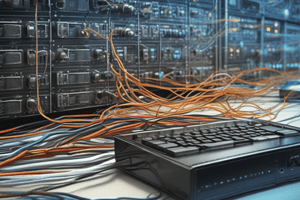Podcast
Questions and Answers
What is the device that works at the Network Layer?
What is the device that works at the Network Layer?
Router
Which devices work at the Data Link Layer? (Select all that apply)
Which devices work at the Data Link Layer? (Select all that apply)
- Switch (correct)
- Bridge (correct)
- Hub
- Repeater
The Data Link Layer sub-layer that provides communication with the Network layer is ________.
The Data Link Layer sub-layer that provides communication with the Network layer is ________.
LLC
The Physical Layer defines the electrical, Mechanical & functional specifications for communication between the Network devices.
The Physical Layer defines the electrical, Mechanical & functional specifications for communication between the Network devices.
Match the following media types with their binary data conversion methods:
Match the following media types with their binary data conversion methods:
What does a switch do in a network?
What does a switch do in a network?
Which device resolves IP addresses to Ethernet (MAC) addresses?
Which device resolves IP addresses to Ethernet (MAC) addresses?
Firewalls monitor and control network traffic based on predetermined security rules.
Firewalls monitor and control network traffic based on predetermined security rules.
The _______________ Layer provides logical addressing and path determination in a network.
The _______________ Layer provides logical addressing and path determination in a network.
Match the following protocols with their descriptions:
Match the following protocols with their descriptions:
Flashcards
Router
Router
A device that forwards data packets between networks based on their destination IP addresses.
Switch
Switch
A device that connects multiple devices on a local network, reducing network collisions by creating separate collision domains.
DNS (Domain Name System)
DNS (Domain Name System)
A protocol that translates domain names (like google.com) into numerical IP addresses.
ARP (Address Resolution Protocol)
ARP (Address Resolution Protocol)
Signup and view all the flashcards
Application Layer
Application Layer
Signup and view all the flashcards
Network Layer
Network Layer
Signup and view all the flashcards
Data Link Layer
Data Link Layer
Signup and view all the flashcards
Physical Layer
Physical Layer
Signup and view all the flashcards
TCP (Transmission Control Protocol)
TCP (Transmission Control Protocol)
Signup and view all the flashcards
UDP (User Datagram Protocol)
UDP (User Datagram Protocol)
Signup and view all the flashcards
Study Notes
Fundamentals of WANs and IP Routing
- A basic local area network (LAN) can be connected using a hub, which is an antiquated device that connects wires together.
- A switch can break up collision domains, resulting in a lot less network congestion.
- A router creates an internetwork and breaks up broadcast domains.
Internetworking Devices
- A router breaks up both broadcast and collision domains for every LAN interface.
- A switch only breaks up collision domains.
- A network with all these internetwork devices in place would have routers, switches, and other devices working together.
How IP Addressing Helps IP Routing?
- IP addressing helps IP routing by providing a unique address for each device on the network.
- This allows devices to communicate with each other and for routers to route traffic efficiently.
Protocols that Help IP Routing
- Domain Name System (DNS) resolves hostnames to IP addresses.
- Address Resolution Protocol (ARP) resolves IP addresses to Ethernet (MAC) addresses.
Physical Components of Network
- WLAN devices connect wireless devices to the network.
- Access Points (APs) allow wireless devices to connect to a wired network and extend a collision domain from a switch.
- WLAN Controllers manage access points in medium to large quantities.
- Firewalls monitor and control incoming and outgoing network traffic based on predetermined security rules.
OSI Model
- OSI model is a layered architecture that consists of seven layers.
- Each layer defines a set of functions that take part in data communication.
- The seven layers are:
- Application Layer (Layer 7): provides an interface for users to interact with applications or networking services.
- Presentation Layer (Layer 6): defines a standard format to the data.
- Session Layer (Layer 5): establishes, maintains, and terminates sessions.
- Transport Layer (Layer 4): provides data delivery mechanism between applications in the network.
- Network Layer (Layer 3): provides logical addressing and path determination (routing).
- Data Link Layer (Layer 2): provides reliable transit of data across a physical link.
- Physical Layer (Layer 1): defines the electrical, mechanical, and functional specifications for communication between network devices.
Transport Layer
- The Transport Layer provides data delivery mechanism between applications in the network.
- The major functions described at the Transport Layer are:
- Identifying service using port numbers.
- Multiplexing and de-multiplexing.
- Segmentation and reassembling.
- Error correction.
- Flow control.
- The protocols that work at the Transport Layer are TCP and UDP.
Network Layer
- The Network Layer provides logical addressing and path determination (routing).
- The protocols that work at the Network Layer are routed protocols (IP, IPX, AppleTalk) and routing protocols (RIP, OSPF).
- Routing protocols perform path determination (routing).
Data Link Layer
- The Data Link Layer has two sublayers: MAC (Media Access Control) and LLC (Logical Link Control).
- MAC provides reliable transit of data across a physical link and error detection using CRC (Cyclic Redundancy Check).
- LLC provides communication with the Network Layer.
Physical Layer
- The Physical Layer defines the electrical, mechanical, and functional specifications for communication between network devices.
- The functions described at the Physical Layer are:
- Encoding/decoding: converting binary data into signals based on the type of media.
- Electrical, mechanical, and functional specifications for communication between devices.
Studying That Suits You
Use AI to generate personalized quizzes and flashcards to suit your learning preferences.




